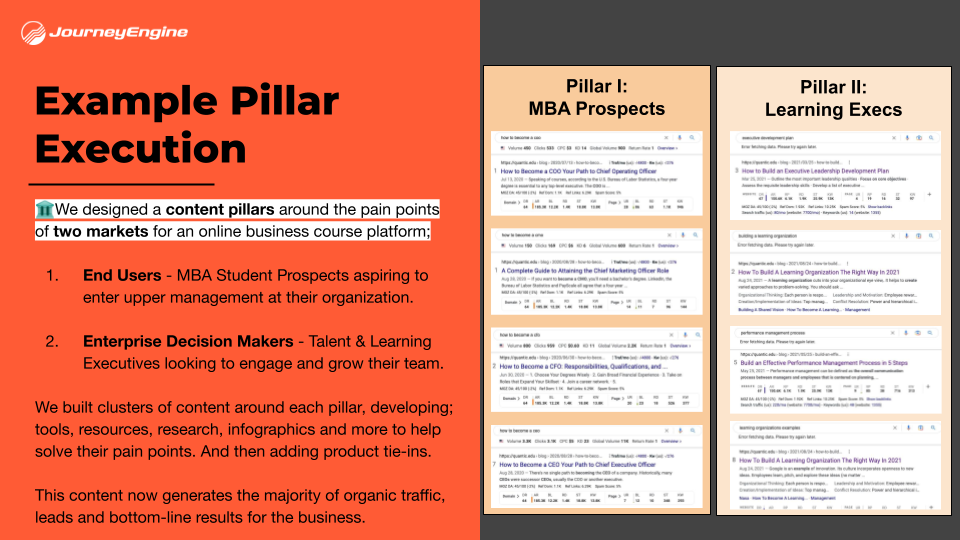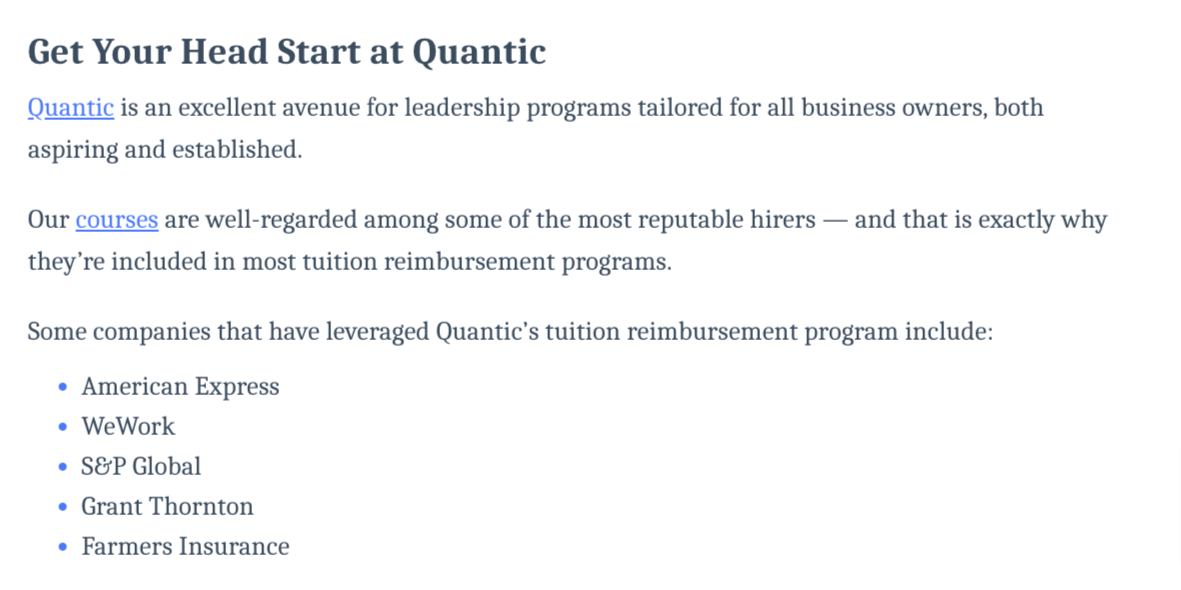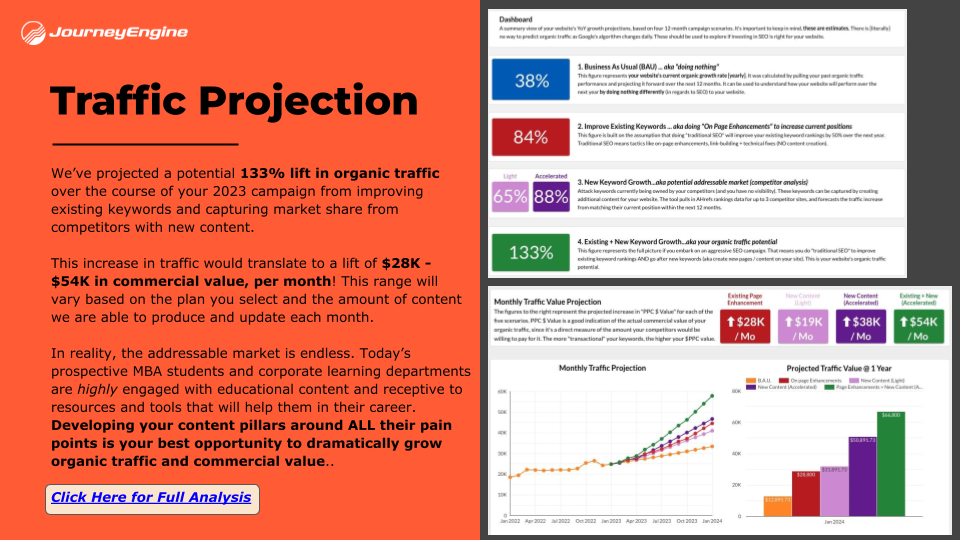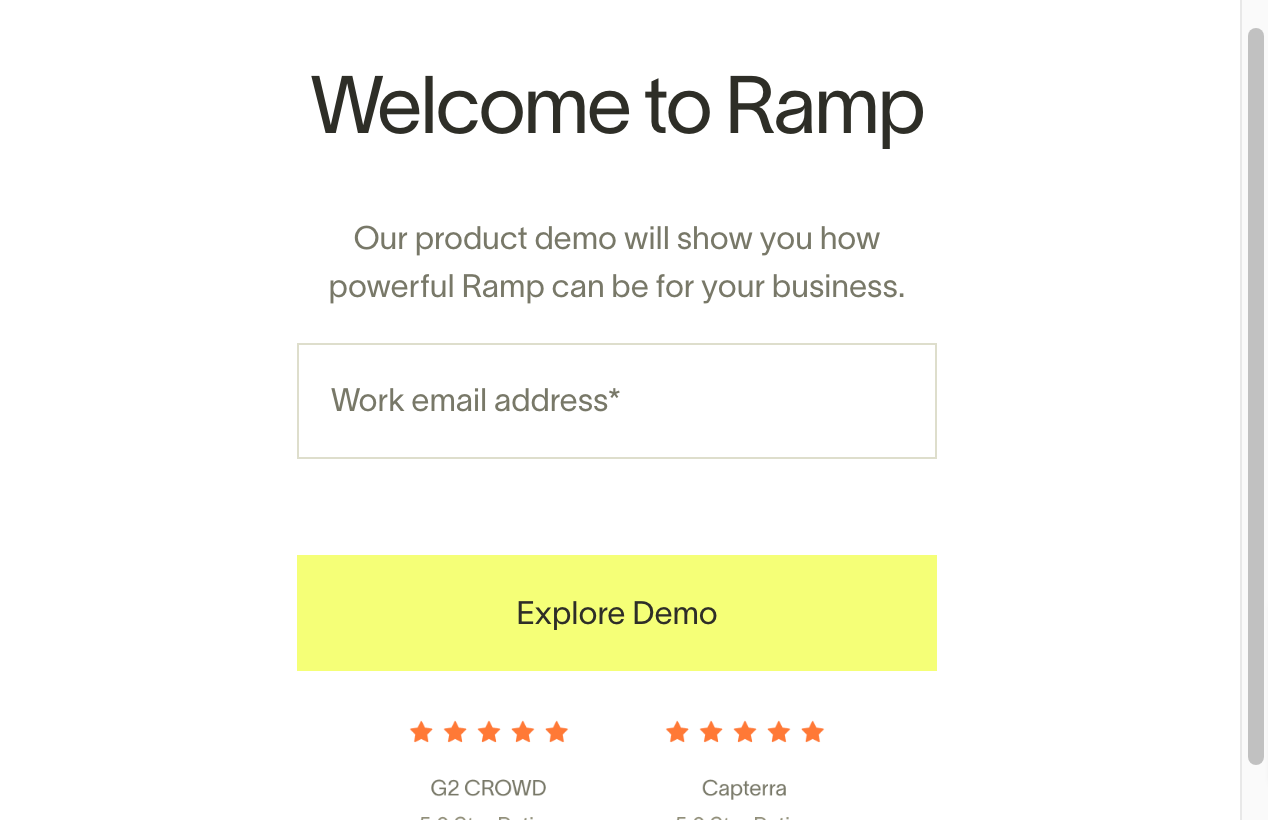Product-Led Content: What it is and How it’s Done [Full Guide]
Struggling to drive qualified traffic and generate leads from your content?
You’re not alone. It's becoming increasingly challenging to capture attention, engage audiences, and drive meaningful results with content.
The market is bloated and saturated. Everyone is competing for attention.
If you find yourself feeling uncertain about the type of content to create, or questioning the effectiveness of SEO in 2023, then you're in the right place.
In this blog post, we're about to unlock the secrets to crafting compelling product-led content.
Content that not only generates leads. But also positions your company as a respected thought leader in your industry.
It’s our full strategy at Journey Engine. We’ve been doing SEO and content marketing for over 10 years; experimenting, learning and trying to get better along the way.
Product led content is BY FAR the best framework we’ve seen.
Table of Contents
What is Product Led Content? (the meaning)
Product-led content is focused on helping customers solve their biggest, most pressing pain points. While showcasing how your product will assist them.
It achieves this through story selling, showcasing benefits and providing educational value.
But it has to be graceful. Here’s a good example…
Highlight how you solve customer problems
Eletive sells employee engagement software. See how we’ve positioned their platform as a (solution) for infrequent performance reviews (problem)?
THAT is what we’re aiming for here.
Product led content isn’t just designed to drive organic traffic from search engines, though.
Most importantly it’s sales enablement.
By integrating your products seamlessly within informative and engaging pieces of content, you can showcase their value in real-world scenarios.
The goal behind creating product-led content is to drive user engagement, generate leads, and ultimately convert those leads into paying customers.
Product marketing vs content marketing
Traditional content marketing usually either sells, eductates or entertains, but rarely does all of those things at the same time.
In the past, most marketers started with sales pages that are entirely focused on the product’s features.
Then they move into creating content that’s interesting to their audience, but has little to do with the product.
Traditional content marketing is overly focused on developing topics that the biggest share your market will find interesting enough to click.
Let’s say you sell a voice based virtual english tutor for kids. Traditional content marketing topics could be…
"5 Essential Tips for Enhancing Your Child's English Language Skills"
"The Importance of Early English Language Development in Children"
Granted this TOFU content can sometimes generate a ton of clicks. But those clicks are usually nothing more than a vanity metric.
Worse yet, these “upper funnel” topics often don’t have any relation to a problem that your product solves.
On the other hand product led content will generate traffic and pipeline. And done right it becomes an evergreen asset.
Key Components of Effective Product-Led Content
Educational Value: Your target audience should learn something new from every piece of product-led content you produce. Whether it's an article about industry trends or a tutorial video demonstrating how to use one aspect of your software solution effectively - always aim to educate first.
Showcase Benefits: Clearly demonstrate how using your product will solve problems or improve outcomes for users by showcasing its key benefits throughout each piece.
User Stories & Case Studies: Share success stories from existing clients who have seen positive results after implementing your solution in their organization - this adds credibility and social proof that can help sway potential buyers towards choosing you over competitors.
Actionable Insights: Your readers should be able to take away actionable tips they can apply immediately after consuming the information provided within each piece - whether it's through step-by-step guides or practical examples of best practices.
Product Marketing Content Types
We aren’t limited to blog posts. There are several content marketing types we can utilize…
Tutorials and How-to Guides: Teach users to use your product effectively.
Case Studies: Show real client success stories to build trust and highlight your product's value.
Demos & Webinars: Interact with interested parties, showcasing your product in real-time.
Videos & Animated Explainers: Use visual media to quickly convey your product's benefits.
Email Campaigns: Nurture leads with tailored content promoting specific aspects of your product.
Blog Posts & Articles: Establish thought leadership and improve SEO rankings.
Now, let’s now look at some live examples. So you can see product led content in action!
Product-Led Content Marketing Examples
Our client Quantic is an app-based MBA program developed by the team who created Rosetta Stone.
When the product went to market, their team was very excited to talk about their unique pedagogy.
They spent years building into the platform. And that became the main focus of their website and content.
Unfortunately, this isn’t the way to approach higher education content marketing. Their student prospects weren’t overly concerned with pedagogy. Some may have not even known the definition of “pedagogy”.. (it means learning methodology btw).
This is a classic example of “selling the shovel” not the hole.
Sell the Hole.. Not the Shovel.
The “hole” is the end goal. It's what people really want. They don't care about the shovel itself (pedagogy); they only care about the hole it can create (higher salary, better prospects, career advancement, etc.).
So, if you can sell the idea of the hole, you can tap into people's deepest desires and emotions.
We did this by developing content “pillars” and “clusters”.
Each major pain point from the ICP represents a pillar. Clusters represent all the different ways the product can help solve each of those pain points.
Design content pillars around your ICP (ideal customer profile)
Quantic.edu has two ICP’s;
MBA student prospects (end users)
Talent & Learning Executives (enterprise b2b decision makers)
The content we created for these ICP’s was slightly different
ICP #1 - MBA prospects
Their main pain point was their difficulty advancing into executive positions.
We created expert guides on how to enter the C Suite. Then we positioned the product (Quantic MBA) as the ideal solution by showing case studies of Quantic alumni who had achieved these titles after graduating from the program.
Position your product as the ideal solution
We wrote expert guides for enterprise learning execs on how to build an executive leadership development plan.
Then we “story-sold” Quantic as the ideal program for executive development, by strategically dropping case studies into the content.
“Story-sell” your Product
Want more detail on the exact process we used? You can read the full campaign case study below:
We increased this EdTech product’s revenue by 20X — through organic traffic!
✅ Page 1 Ranking on Target Keywords for all Content Pillars.
📈 3X the Organic Site Traffic (Hockey-Stick Growth)
💲 PPC Value Upwards of $100K per Month (Ahrefs).
💰 20X Increase in Conversion Value (per Google Analytics).
🔄 29X ROI for JourneyEngine’s Content + SEO Service.
Want to learn how we did it, step-by-step?
Another example of product led content from the HR Tech space is our client Workvivo.
We wrote an expert guide on how to do an internal communications Audit. Then embedded a webinar on how to use their product to do that.
You can see the full case study and results of that campaign here.
More Examples of Product-Led Content in Action:
1. HubSpot's Inbound Marketing Certification Course
HubSpot's Inbound Marketing Certification Course is a prime example of product-led content marketing. This free course not only educates users on inbound marketing techniques but also demonstrates the power and utility of HubSpot's suite of tools throughout the learning process.
2. Canva Design School
The Canva Design School offers an extensive library of design tutorials, articles, and resources that teach users how to create visually stunning graphics using Canva's platform. By providing valuable information and tips, they encourage users to explore their tool further.
3. Grammarly Blog & Browser Extension
Grammarly's blog presents informative articles about grammar rules, writing tips, productivity hacks - all while subtly promoting its browser extension as a helpful solution for improving one's writing skills.
4. Slack Tips Blog Posts
Slack shares tips on using its platform more effectively through blog posts that offer practical advice and demonstrate how specific features can enhance productivity for users.
Duolingo offers engaging stories designed to help language learners practice reading comprehension skills while showcasing the benefits of using their app regularly for learning new languages.
How To Create A Product-led SEO Content Strategy
We like to think of product-led content as advanced SEO.
The goal of Beginner/basic SEO is to generate the most possible organic traffic.
That process starts and ends in keyword research tools. The entire purpose of the campaign is to optimize keywords with the highest traffic potential. Often the product customer facing teams aren’t even involved in the process.
That’s backward.
The goal of Product-led content is to generate revenue pipeline from organic traffic.
It’s the future of content marketing.
You start with a deep understanding of customer pain points. Then develop different clusters of content that are around solving those pain points specifically. After you do that, you’ll validate those topics with the best possible keywords that are specifically related to those topics.
We will go into more detail on how to do that in this section. You can also discover our full process in the video below…
Step 1: Forecast the Desired Result and Set Goals
When you’re planning how to allocate marketing resources, starting with a forecast is a smart move.
You should be able to project the impact a campaign will have on your bottom-line over the short and long term.
That way you can know how much to spend.
Our agency developed a forecast process that uses data points from the competitors and the company’s analytics data to show them the size of their market, how much of it they should expect to capture with product-led content and the resulting revenue.
Want your own Product-Led ROI Forecast?
Learn what Product-Led content can do for your business
Discover the Biggest Opportunities for Your Website
Forecast Traffic and ROI from your Campaign
Sell-through Product-Led Content to your Team
We run that report for free for every prospect, before starting any campaign.
It qualifies the value of the campaign to us and for them.
We need to know that the campaign is going to be sustainable over the long haul, in order for it to be worthwhile for any of us.
Only move onto the next section once you’ve established product-led content will generate ROI for you.
Step 2: Identify your Prospect’s Pain Points
Nail down the biggest pain points for each ICP. That’s the goal here.
The best way to do that is by talking to the customers and getting information from them.
In the absence of being able to talk to the customers, the best way possible to get this information is to have a really good relationship with the following people…
The sales team: they’re talking to prospects every day. And know every objection
The support team: they’re dealing with the problems customers have every day
The success team: they know how your product helps customer overcome their problems
Form a really tight relationship with these people.
Get direct quotes from them about what the customers biggest problems are, and how the product can best solve those problems.
Step 3: Build Topic Clusters Around Your ICP’s Pain Points
Product-led content is designed to help prospects with pain points that can be solved by the product.
It’s not enough for the topic to just be something the audience is interested in.
Example: an internal communications software targeted to HR managers.
Bad content: ”The top 133 conferences in the USA for HR professionals” ❌
Good content: “How to do an internal communications audit” ✅
The first topic is relevant to that audience, and it would probably drive lots of traffic. But it’s not really a product-led topic, because it doesn't have much to do with what the product solves.
In a product-led strategy, every topic should always:
Directly drive demand for the product
Double as sales enablement
If your sales team wouldn’t want to show it to a prospect, it’s probably not a topic we’d consider for the product-led strategy.
How does product-led content impact the customer journey, and what role does it play in the sales funnel?
Map Your Content to the User Journey
You can look at at the customer journey as the various stages of awareness;
1. Unaware: Not aware they have a problem
2. Problem Aware: know their problem and looking to fix it
Content Tactic: Develop educational content to help solve their problem and introduce your product as a critical part of the solution.
3. Solution Aware: looking for a product like yours to solve their problem
Content Tactic: Create program, features and benefits pages detailing exactly how your product will solve their problem.
4. Product Aware: know about your product and evaluating it against others
Content Tactic: Create stories of existing customers and use cases of others who have solved the same problem.
For the internal communications software example, you could create a 10 topic cluster around Internal communications audits.
The goal is to find what people are searching for in each of the awareness stages and develop content for them.
Aim for a range of “content types”, ranging from blog posts to white papers.
Selecting the right mix of content types depends on what your goals are, and what content your site is currently lacking.
For example, if we’re going to publish 5 blog posts on internal communications software, then it makes sense to also create/publish a case study that you can embed in each of those blog posts to show authority.
And another piece of gated content so you can drive leads.
Everything words together.
Keyword research is part of the process, but it’s secondary.
You use keyword research to optimize these topic clusters, through the lens of finding queries that can be tied to problems your product solves.
💡Pro tip: we've actually even seen zero volume keywords sometimes generate the most bottom-line value for businesses. So take the information from your SEO tools with a grain of salt.
Once you have your list of 10 topics you can move onto creating/publishing that content on your site.
Step 4: Create Content Using Your Team’s Original Perspectives
The teams with the pulse on customers are the sales, success, and support teams.
You used them in step two to tease out pain points. That helped inform your topic selection.
Now you’re going to use them again when writing the content. Why?
They possess valuable knowledge about real pain points and customer needs.
So as long as your content team can interface with these stakeholders?
It’s literally impossible to create “flat” content.
Your writers will be tapping into information that’ll help them create content that genuinely helps and engages their target audience.
Doing things this way ensures your product-led content is both informative and engaging.
Furthermore, your content is more likely to rank on Google.
Google’s latest update is entirely focused on “EEAT” - Experience, Expertise, Authoritativeness and Trust. They want to rank content that’s based on original perspectives of people within your organization. That’s perfect for the product-led approach, since your process starts with your team’s perspectives.
By sharing content that provides exceptional value for free, you can establish yourself as trusted authority in your industry.
Tips for Creating Valuable, Product-Led Content
Showcase real-life applications: Demonstrate how your product can be used in various scenarios or industries by sharing case studies or customer testimonials.
Create educational content: Offer value through guides, webinars, or courses that help customers learn more about your industry while highlighting your product's features and benefits.
Utilize social proof: Share success stories from satisfied customers to build trust and credibility with potential users.
Incorporate interactive elements: Use quizzes, polls, or surveys to engage your audience while subtly promoting your product as a solution for their needs.
Create Clear Calls-to-Action (CTAs): Include clear CTAs in strategic locations throughout your blog posts, articles, and other pieces of content. These could be buttons or text links encouraging readers to sign up for a free trial, download an eBook or whitepaper related to the topic at hand or even schedule a demo.
Step 5: Use Your Product-Led Content to Generate Leads
There are a few different perspectives on generating leads with content.
Some businesses prefer not to use an explicit “device” for lead generation. They leave all of their content “un-gated” and never explicitly ask for contact info within the content other than a CTA to schedule a demo.
This feels more natural and isn't pushy as other tactics, but you won’t generate THAT many MQL’s.
⭐ We recommend using gated content in the form of content upgrades like downloadable PDFs, guides, whitepapers and courses. Once a lead signs up they become an MQL. We then nurture those MQL’s into demos with a follow-up email sequence.
A good example of this is Ramp (fastest growth in SaaS in history). They use a public interactive product demo (and "explore product" as their CTA).
Use interactive product demos to generate leads
Ramp used a public, interactive demo to grow faster than any product in SaaS history!
Another powerful and emerging method to generate leads is with an interactive demo. That lets your market self-test the product.
You can use a solution like navattic.com or Walnut.io to implement these.
Step 6: Measure Campaign ROI
It’s time to make it rain!
If you’ve implemented everything in this guide so far, you’ll be putting out content that is better than 99.9% of what's out there.
Now you need to track the result of your efforts…
At the base level you want to be able to track the traffic, leads and projected lifetime revenue of each piece of content you publish.
Doing this properly requires marrying your site analytics and CRM data.
You’ll need to compare that value against all the associated marketing spend to get your final ROI.
“Track the traffic, leads and lifetime revenue of each piece of content you publish.”
Marry your site analytics and CRM data to calculate conversion value.
Compare that value against marketing spend to get your final ROMS (Return on Marketing Spend).
If you’re evaluating a vendor or employee, things are a little more difficult. But I’d also recommend factoring in “return on process”.
Have they built a program into your business process that you own?
Can you use it to develop, test and improve your content forever?
Does it improve efficiencies, reduce and eliminate other internal costs over time?
If so, then you should certainly consider hiring them.
At Journey Engine we aim to give you a high ROI and return on process. If you’d like to “try before you buy” you can schedule your free traffic projection here.
It’s your first step towards working with us :)
Conclusion
Product-led content is a powerful strategy that helps businesses stand out online, attract customers, and achieve results.
It goes beyond traditional marketing by addressing customer pain points and showcasing how your product solves them. This type of content educates, engages, and converts leads into customers.
To build a product-led SEO content strategy, you need to understand customer pain points, create relevant topic clusters, and engage your sales, support, and success teams.
Hopefully this guide will help you do that successfully.
But we’re happy to provide assistance if needed. Simply email justin@journeyengine.com. Make the subject line “traffic projection”.
Want Your Own Product-Led Content Strategy and ROI Forecast?
Learn what Product-Led content can do for your business
Discover the Biggest Opportunities for Your Website
Forecast Traffic and ROI from your Campaign
Sell-through Product-Led Content to your Team
FAQ
1. What is a product-led strategy?
A product-led strategy refers to an approach where businesses prioritize their products as the main growth driver. By delivering exceptional user experiences, offering self-service options, and using data-driven insights for improvement, companies can acquire new customers organically and foster long-term loyalty.
2. What does it mean to be product-led?
"Product-led" describes an organizational mindset where the focus lies on developing high-quality products that deliver value to users. In this model, customer satisfaction takes precedence over aggressive sales tactics; thus allowing word-of-mouth referrals and organic growth to drive business success.
3. What is product content?
Product content encompasses all types of information related to a specific item or service offered by a company. It includes descriptions, specifications, images, videos, tutorials, or any other material aimed at educating consumers about its features and benefits in order to facilitate informed purchasing decisions.
At Journey Engine, we believe that product-led content is essential for businesses looking to succeed in today's market. By creating content that is centered around your products and services, you can educate potential customers, build trust, and ultimately drive conversions. To learn more about how we can help you create effective product-led content, contact us today.
Where do you see product led content going in the age of AI?
Product-led content is the only model for the age of AI.
AI can now generate good quality curated content pieces, instantaneously.
At the same time Google has increased their focus on “experience and expertise” in determining the quality of your content. Essentially, they want to know that the perspectives in your content are generated from people within your business.
If you’re not basing your content on inputs and original thought from your team then it’s going to be very difficult to compete with companies who are. You’re competitors can instantaneously duplicate that level of content.
AI can help you fill in the blanks, but unless you're driving it with your own originality the product is always going to be boring and banal.
If possible, I recommend interviewing members of your customer-facing teams about how your product solves critical pain points. You can repurpose their original perspectives into written word – this makes for quality, original perspectives and content that’s impossible for your competitors to duplicate.











